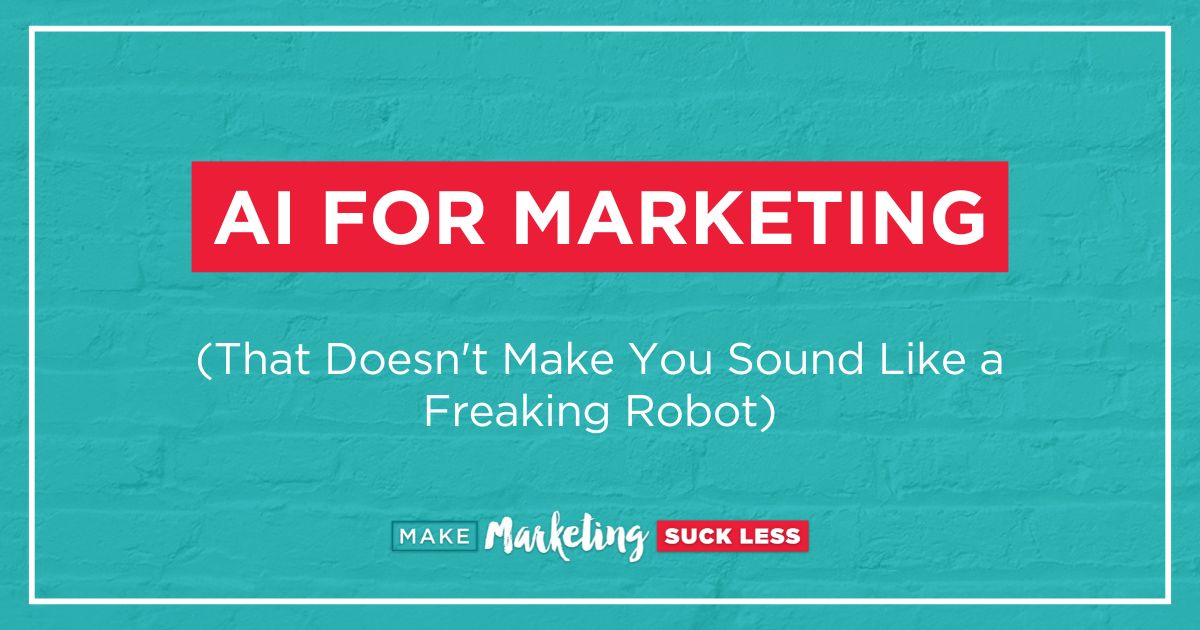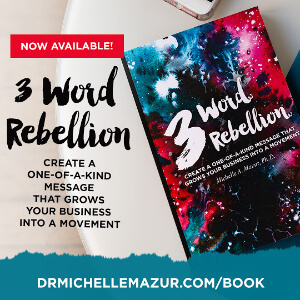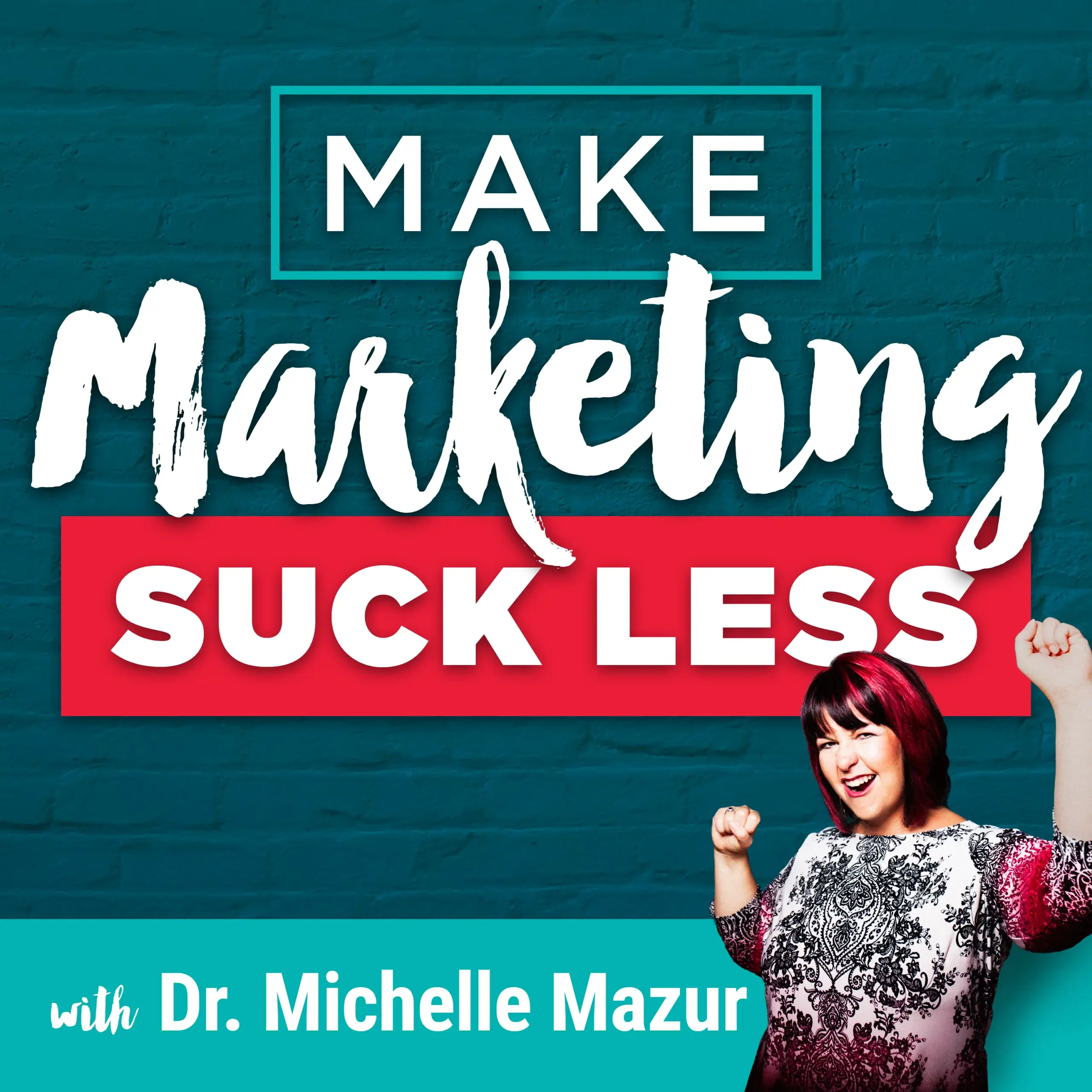Make Marketing Suck Less
AI for Marketing That Doesn’t Make You Sound Like a Freaking Robot
By Michelle Mazur > April 1, 2025
Filed Under Podcast

AI is everywhere in marketing right now, and I get it—it's tempting to let it do all the heavy lifting.
But if your strategy is just “Hey, Claude, write me 10 LinkedIn posts about email marketing,” then we need to talk. Because that approach? It's turning business owners into content-producing robots, all sounding the same. Like the Borg. “You will be assimilated.”
So, let’s pull back the curtain. AI isn’t here to replace you—it’s here to amplify your unique thoughts, ideas, and experiences. Here’s how I use AI to make marketing suck less while keeping my voice and message 100% human.
(Click play or read the transcript below.)
Table of Contents
What I Don’t Use AI For
1. Voice of Customer Research
AI can analyze data, but it can’t replace real conversations. If you rely on AI to tell you who your customers are and how they talk about their struggles, you’re getting generic, surface-level insights. True understanding comes from listening to actual people—through surveys, interviews, and intake forms.
2. Messaging Development
Your messaging is the heartbeat of your business. Handing that over to AI is like giving away your brand’s soul. AI can be a thought partner, but if you let it fully create your messaging, you’ll sound just like everyone else.
3. Generic Content Creation
I don’t use AI to generate bland, one-size-fits-all content. I don’t ask it to write podcast scripts from scratch or come up with entire blog posts on its own. Instead, I use it to structure and refine my own ideas.
How I Do Use AI
1. “Human In, Human Out” Approach
I always start with my own insights. AI doesn’t think for me—I use it as a tool to refine and structure my thoughts. This keeps my content fresh, original, and deeply rooted in my expertise.
2. Streamlining My Email Writing Process
Before AI, writing my weekly newsletter took me 3–4 hours. Now? About an hour. My process:
- Brain dump my thoughts using an app like Otter or Oasis.
- Feed the transcript into Claude (my AI of choice) to organize my ideas.
- Edit the AI-generated draft to ensure it sounds like me.
This keeps my emails personal and authentic—AI just helps me get there faster.
3. Clarifying My Thinking
Some ideas are hard to articulate clearly. Instead of spending hours struggling with wording, I:
- Talk through my ideas into an app.
- Upload the transcript to AI and have a “conversation” to refine the concept.
- uUe AI’s suggestions to distill my thoughts into something concise and compelling.
4. Creating an AI Assistant (Moxie) for My Community
I’m building Moxie, an AI assistant for the Expert Up Club. But she’s not here to generate content—she helps members process and synthesize their messaging. Whether it’s analyzing voice of customer data or testing different “why buy” statements, Moxie speeds up the process without replacing human creativity.
5. Repurposing Content Smarter
With nearly 400 podcast episodes, I have a ton of content. AI helps me:
- Extract new angles for emails and social posts.
- Suggest ways to turn a podcast transcript into a LinkedIn post.
- Generate starting points for repurposing, which I then refine.
The Key to Using AI Effectively? You.
AI isn’t a magic button—it’s a tool. The secret to making AI work for you is keeping your ideas, expertise, and voice at the forefront. Use AI to amplify what makes you unique, not replace it.
Marketing doesn’t have to suck. AI can help—but only if you use it the right way.
Learn more about Michelle Mazur:
- Market Like An Expert, 7-Day Course
- Join The Expert Up Club
- Get the Make Marketing Suck Less Newsletter
- Request a free 1:1 Chat
- Connect with me on LinkedIn
Listen on your favorite podcast player or read the Transcript below:
Michelle Mazur [00:00:00]: Hey, Claude. Write me 10 LinkedIn posts about email marketing. Is that how you're using AI in your business? Or you think you should be using AI in your business that way? Because of it is, we need to talk. That approach is turning entrepreneurs and business owners into content producing robots who all sound the same. It's like the borg. You will be assimilated and sound and think like everyone else. So today, I am pulling back the curtain on how I'm using AI to make marketing suck less while staying 100% human. And spoiler alert, it's not about AI replacing you. It's about amplifying your thoughts, your ideas, and experiences. Michelle Mazur [00:00:59]: Welcome to Make Marketing Suck Less. The podcast that knows marketing is freaking hard, especially when you're a solo business owner trying to juggle it all. I'm your host, Dr. Michelle Mazur, author of the 3 Word Rebellion and founder of the Expert Up Club. Forget the latest marketing fads and tactics promising social media stardom. I'm here with research-backed strategies to help you clarify your message and get twice as effective with your marketing. And while I can't promise you'll ever love marketing, I'm here. to make you hate it a tiny bit less. Michelle Mazur [00:01:47]: I've always been an early adopter of technology, and I'm gonna totally date myself here. But back in the day when the Internet was young, there were these things called bulletin boards where you could log in and talk to people all around the world. It was text messaging before text messaging was a thing. And I freaking loved doing that. I got to meet really cool human beings, and it was fun. So when AI came on the scene, I was really intrigued with how to use this to make marketing suck less. And I know there's been a lot of discussion about, like, oh, it's inauthentic to you as AI, or you can spot AI a mile away because they use the em dash or certain words in those posts. And my issue isn't that people are using AI for their marketing because it is going to be used. This is the way that business is heading. And I understand, like, AI has plenty of ethical and environmental considerations we should be thinking about for sure. Michelle Mazur [00:03:10]: My question is, how do you use AI without losing your humanity, without sounding like everyone else? And use it so it can make your marketing suck less. And that's what we're diving into today. And I'm taking you behind the scenes of my own business about how I'm using AI as a basic marketing assistant that's making my job easier and making me a better marketer. But let me be super clear about how I don't use AI in my business. I don't use it to figure out my voice of customer research. I once had a meeting with another business owner who created an AI tool that was like, you'll never have to do voice of customer again. And my issue is that if you are relying on a large language model to tell you who your customers are and how they talk about the problems they're having in their lived experience, it is scraping the internet, and you are going to get the lowest common denominator because the people you work with are unique and they have a unique way of speaking and seeing the world and AI can't capture it. The real insights come from actual conversations with real people who have real problems, whether that's a survey or digging through intake forms or doing interviews. Michelle Mazur [00:04:50]: And AI is great at helping you analyze what you find, but it can't replace you reaching out to another human being and talking to them about their life. The second way I don't use AI, I don't outsource it to do my messaging for me. My messaging is the heartbeat of my business. It's what makes me different from everyone else, and I'm not about to hand that over to a robot. I do think it can be a thought partner for you, but you should not have it create your messaging because you will sound like everyone else, and no one will have a compelling reason to choose you. I don't use it to write generic stuff. Like, I don't use it to write a generic podcast script. Michelle Mazur [00:05:51]: Like, I didn't say, hey, Claude. How should I use how could I use AI in marketing? Write me a podcast script. I actually gave him ideas and then had him do the heavy lifting of structuring the script, which is kind of ironic, but the brain dumps, that human touch is so important to me. Because when we're using AI to market, it does require human touch, real insight, and that certain something that happens when you just deeply understand your people, when you're able to make your people feel seen, heard and understood. So now that we've talked about my don'ts, now let's talk about how I do use AI. My approach is what I call human in, human out. I never ask AI just to write a thing for me or do customer research. That's what I call lazy AI because it's just gonna give you generic, boring content that sounds like everyone else, and you're different. The human in your business is what makes you unique, your perspective on the world. Michelle Mazur [00:07:03]: So I'm not going to ever just have AI do something for me. Everything for me is human in, human out. There has to be those human touch points. So let me give you an example of how I write my email newsletter. Before AI, I would probably spend three to four hours each week writing my newsletter. Ideas come to me very quickly, which is awesome. But translating those ideas into words on a page that another person could understand, that's a heavy lift. And that takes me forever. Michelle Mazur [00:07:44]: Plus, I have a terrible habit of writing while I edit, which slows everything down. I've tried to break that habit, and I just can't. And since I'm an external processor, being a borderline extrovert, I use an app like Otter or Oasis, and I just talk my thoughts out about what I want the newsletter to say. I get that transcript, and then I take it to my AI tool of choice, Claude. And you might be wondering why I chose Chuck Claude over ChatGPT. Number one, I like how Claude writes better. Number two, I like that you can create projects that use the information that you give it as its own database, so it's not scouring the web for ideas. But instead, it's just looking at what you gave it instead. Michelle Mazur [00:08:39]: So that's one of my favorite things about Claude. So when I'm going to use Claude, I will set up an email marketing project, or I have set up an email marketing project. And I gave it information about my business, my voice of customer research, information about my brand voice and how I speak. I've given it sales pages through the Expert Up up club, past emails I've written. It has the Market Like An Expert course, which, by the way, if you wanna create a social media optional marketing strategy that creates more demand for your work while you market less, you should totally pick that up if you haven't. It is at drmichellemazur.com/mle, or just open the podcast app and click on the link for Market Like An Expert. So all of this information that I've given, Claude, it gives a context about me, who I am, how I show up, how I speak. And then I can give it more specific instructions to maintain my brand voice. Michelle Mazur [00:09:44]: Don't use certain words like empower, magnetize, or transform, and avoid cliche statements that AI tends to lean in on. So then I can take the brain dump of the transcript of my brain dump and say, hey. Use this to create a first draft of an email. And Claude does usually within a few seconds. But here's the crucial part. I don't use that first draft as is. No. I usually go for a walk or wait 24 hours, and then I put it in a Google Doc and edit it line by line, making sure that each line sounds like me, delivers the message that I intended. Michelle Mazur [00:10:29]: And if it sounds a little too AI-e, I can just edit that. And then I just load it up into ConvertKit or kit, I guess, is now what it's called, and it's ready to send. And this process has taken my email marketing from three to four hours to about one hour, which is amazing. I'm maintaining my humanity, but AI is doing the heavy lifting that would have taken me three to four hours to do before. Its such a time saver. A second way I use AI in my marketing is to flesh out ideas. I have a lot of thoughts running through my head that I can't articulate succinctly, that it would take me so many words to tell another human. And I just can't process that information and figure out a way to communicate it in a way that makes sense. Michelle Mazur [00:11:26]: So what I can do is, whip out my app, babble it out, and upload it to Claude and have a conversation. And this process really helps clarify my thinking. And even very soon, I am also creating an AI assistant for the Expert Up Club. She's called Moxie, and she's not there to create for you. She's there to help you synthesize and process information so you can find insights easier, whether that's figuring out voice of customer research, whether that's giving you multiple drafts of your problem statement based on the inputs from your voice of client and what you know, whether that's experimenting with different types of why buys based on what you put into her. She can help you mad lib different pieces of messaging and with your discernment, come up with something that will work with you. So it takes out the overthinking that I see a lot of experts go through when they're going through the messaging sprints. Like, they're great at the brain dumps, but when they start to synthesize that and create the messaging, they start to overthink. Michelle Mazur [00:12:42]: And AI can take that overthinking out of the process. So it's super valuable. And PS, we have the doors open for the Expert Up Club right now until April 10, 2025. So if it is time to create your messaging or you feel like your message isn't resonating any more, head on over to expertup.club, book a private tour with me, and I'd be happy to show you around and how we can help you nail your marketing message so you always know what you say is actually leading to clients. Now the final way I use AI is to repurpose content. And if you've been around for a while, I am guessing you have a lot of content you have created. Like, dude, this is episode 392 of this podcast. I'm sitting on a gold mine of content. Michelle Mazur [00:13:46]: So what I can do is I can give Claude a podcast transcript and say, hey, what are some different angles I could write an email about? Or if I'm gonna post on LinkedIn, what are some LinkedIn posts that I could do based on this podcast? And he tells me what angles and I get to choose, like, oh, I really would like this angle. Can we write a first draft of that? And then once again, I take it and I edit it and I make it my own. That's my approach to AI. I want it to sound like me. I just wanna use it as a tool to help me be more efficient, not to take away my ideas, my experience, my expertise, the way that I see the world, but it's really helping me amplify it. And that is how you can use AI to make marketing suck less. Michelle Mazur [00:14:45]: If the Make Marketing Suck Less pod is making your marketing more effective so that your clients can find and hire you, please share the show with a friend. The easiest way to do that is through pod link. You can find the show at pod.link/rebel, and that page will allow anyone you share the show with to subscribe and start listening in their favorite podcast player. That's pod.link/rebel. The Make Marketing Suck Less podcast is a production of Communication Rebel. Our production coordinator is Jessica Gulley-Ward. The podcast is edited by Steven Mills, our executive producer is me, Dr. Michelle Mazur. The make marketing suck less podcast is recorded on the unseated traditional lands of the coast salish peoples, specifically the first people of Seattle, the Duwamish people, original stewards of the land, past, and present.
Enter your name and email address below and I'll send you periodic updates about the podcast.
Sign up to receive email updates
Create Your One-of-a-Kind Message
Your 3 Word Rebellion is the Key to Growing Your Business & Impact






